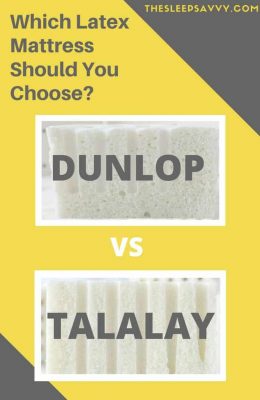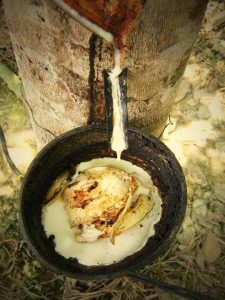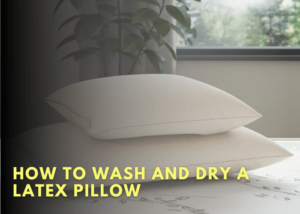We hope you love the product we recommend! Just so you know, at no extra cost to you, we may get a small commission for purchases made through links in this post. Your support is appreciated. Enjoy the read!
Most of us have heard of latex before, but do we really know what it is?
If you don’t, that’s OK.
On a very basic level, latex mattresses are a natural and durable but pricier mattress option.
Let’s learn more about the differences between Dunlop vs Talalay latex!

How is Latex Made?

Latex foam is derived from the sap of the Rubber Tree – Hevea Brasiliensis. A native plant to rainforests in the Amazon, this tree is now found in Southeast Asia and Western Africa.
Some people even call it the “sleeping tree sap” or “latex tree”.
Rubber tapping is the process of collecting the tree sap from the rubber tree.
If you thought that this is a complex process, it is not.
The collectors make a groove into the bark of the rubber tree using a special knife. Then, they peel the bark for the sap to flow out.
Excellent tapping also means that they harvest the latex at the right time. Typically, when the tree is six years old and six inches thick in diameter.
Different Types of Latex
There exist three categories of latex mattresses: natural, synthetic, and blended.
Natural Latex
Natural latex is also called botanical latex.
It is organic, pure, and all-natural.
This type of latex is very strong, and it has an average lifespan of 7 to 8 years.
It has a good conforming ability because it hugs you closely and comfortably.
Natural latex has great temperature sensitivity because it is very breathable, allowing proper airflow when you sleep.
It gives off less of a scent, but it costs more than the other types of latex mattresses.
Synthetic Latex
Synthetic latex is made in the laboratory, and it has 0 to 30% of natural latex.
It has an average lifespan of between 6 and 7 years, plus it has a fair conforming ability.
Synthetic latex is not ideal when it comes to temperature sensitivity because it produces excessive warmth.
On top of that, it has a rubbery smell because of the synthetic latex layers.
Fortunately, synthetic latex is well-priced.
Dunlop vs Talalay: Two Methods to Make Latex
There are two methods to process latex.
Dunlop – More Eco-friendly
The foam to air ratio is higher, hence the density is higher, which means it’s typically more firm and lasts longer.
It also requires less processing, so it’s more eco-friendly.
Historically, Dunlop’s firmness has been known to be inconsistent, but with advanced technology, that’s no longer an issue.
Dunlop Step-by-Step Process
The method of processing Dunlop latex started in the 1920s, and here’s how it’s done.
- First, the liquid latex extract is whipped to create a froth.
- The foam is injected into a mold for shaping
- The shaped mold is baked in an oven.
- The shaped latex is removed from the mold, and then cleaned.
- The latex has to be baked again to remove the excess moisture.
Dunlop latex is mainly used as a support layer in latex mattresses.
Pros of Dunlop
- Quite eco-friendly
- Not too bouncy
- It is dense
- Soft and springy
- The production process is expensive and needs a lot of work
Cons of Dunlop
- The density is not consistent
- Less durable than Talalay latex
Talalay – More Affordable
The air to foam ratio is higher, so it’s able to better conform to the body.
You WON’T see “100% Natural” or “GOLS certified” Talalay latex because a large amount of air and synthetic materials are added to achieve that “luxury” soft feel.
Typically, it’s more expensive because it takes 4x as long and uses 5x as much energy to produce.
In the market today, most mattresses will use both to form a latex bed – Talalay on the surface for a softer feel and Dunlop underneath for support.
Talalay Step-By-Step Process
The Talalay latex process started after the World War II, and it requires more work and capital when compared to the Dunlop latex process.
- The first step includes whipping the liquid latex extract into a froth.
- The next step involves partially filling the mold with the foam.
- The mold is vacuum-sealed to allow the latex to expand so that it can fill up the mold.
- The molded-latex is flash-frozen. This step includes pushing carbon dioxide through the latex to make the foam more breathable and lighter.
- The frozen latex is baked and then removed from the mold for washing and drying.
Talalay latex is less dense, and softer than Dunlop latex.
It is also lighter, and that’s why it’s best used as a comfort layer material.
Pros of Talalay
- Quite durable
- Delivers a wide range of firmness levels
- Feels like a memory foam mattress
- The density is consistent
Cons of Talalay
- Cannot be produced 100 % naturally
- It is expensive
- Less strong
Dunlop vs Talalay: Which One Is better?
Well, that really depends on what you’re looking for. This is our recommendation:

While Talalay Latex is for people who like their mattress a bit softer and bouncier, value affordability and don’t mind that it’s not 100% natural.
If it’s your first time buying a latex bed, we’d advise you to go with a Dunlop as most people don’t enjoy the overly springy or bouncy feel of a mattress. But if you do, go ahead with the Talalay!
Pros & Cons of Latex Mattress
- Natural & hypoallergenic
- Consistent air flow - never overheat
- Long-lasting
- Conforms & regains shape FAST
- heavy
- Not Cheap
Latex Mattress Benefits
As with all foam, latex is also able to isolate movement, provide pressure point relief and support the spine to stay in natural alignment during your sleep.
What makes latex unique and coveted is its:
- natural ability to ward off dust mites and mold, making it the healthiest option – a huge advantage in humid climates
- open cell structure to allow consistent air flow, so you’ll never sleep hot long lasting durability
- long-lasting durability
- speed to take and regain shape – memory foam slowly conforms to your every curve, whereas latex is quick to indent to the general shape of your body (I guess this could be a pro or a con, depending on how you look at it)
Downside of Latex
The only two downsides are:
- heavier than other foam
- pricer due to the manual labor process of collecting the tree sap
Can some genius please invent a way to automatic it so we can get the cost down already?!
SAVVY TIP
Because of the cost, people like to just buy a latex mattress topper. It's not exactly the same thing or feeling, but it's a little slice of latex heaven if you really want to sleep on one.
Latex Mattress Allergy
It’s pretty rare.
You probably don’t have too much to worry about.
According to the Asthma and Allergy Foundation of America, <1% of people in the US are allergic to latex.
It’s the protein in the natural rubber that triggers allergic reactions, ranging from mild eczema to the more fatal anaphylactic shock.
Well, you know what they say.
The best treatment is prevention! So avoid it if you know you are allergic.
If you can’t live without your latex bed, opt for Talalay.
The Talalay method is 4x as long as Dunlop because it has 5 rounds of washing.

It’s also not 100% natural latex (there’s some synthetic material in it), maybe that’s why there are fewer reports of allergy responses.
Some allergies develop over time and by repeated exposure.
Tricky, I know!
If you get any signs of itchy, red spots on your skin, it’s time to chat with your doctor and get an allergy test done.
Impression Load Deflection – What’s That?
Impression Load Deflection (ILD) measures the amount of weight needed for the foam to sink 1″ below the mattress surface.
Basically, this tells us how hard or soft the latex foam is.
ILD and density have a positive relationship – the higher the ILD, the denser (read: firmer) it is.
So, if we are comparing 18 ILD with 24 ILD – the first one is softer.
Makes sense, yes?
GOLS Certification
It’s not easy getting this certification!!
Having the Global Organic Latex Standard (GOLS) certification means the latex contains more than 95% certified organic raw material.
 GOLS also governs the entire cycle from manufacturing to processing to packaging.
GOLS also governs the entire cycle from manufacturing to processing to packaging.
They require annual inspections, as well as separate storage from regular latex material. This strict regulation makes sure the product is safe, natural and sustainable for me and you to use.
Now you know if a product has the GOLS label on it, it’s the real deal!
Dunlop vs Talalay Latex FAQ
Is Talalay latex toxic? How about synthetic latex?
Talalay latex is non-toxic because its production process removes any harmful substances.
But, synthetic latex is considered toxic because it is made using toxic chemicals.
What is arpico latex?
Arpico latex is mattresses made of 100 % natural latex foam.
They are made from the Arpico rubber tree.
Do latex mattresses need to be turned?
You don’t need to flip your latex mattress because they don’t wear in the same manner as traditional mattresses.
Do latex mattresses break down?
Latex mattresses are designed to last long, and that’s one of their greatest strengths.
Depending on the construction of your mattress and how well you take care of it, it may maintain its shape and form for up to 20 years.
Do latex mattresses smell?
Usually, synthetic and blended latex mattresses produce a pungent rubbery smell because of synthetic latex.
Are latex mattresses hot to sleep on?
This is a misconception because people compare latex mattresses to memory foam.
The fact is that a latex mattress allows adequate aeration, which is better than a majority of other types of mattresses.
How Long Does a Latex Mattress Last?
That depends on so many factors like what’s in the latex, how often do you use the bed, how much weight do you put on it normally, how well you maintain it, among other factors.
As a general reference, 100% natural latex bed can easily last for 20-30 years.
A Talalay latex mattress, which cannot be 100% natural (keep reading to find out why!), can still last a good 7-10+ years, like a regular mattress.
That’s a wrap!
Now that you know the difference between Dunlop vs Talalay latex, keep learning other secrets for a deeper sleep!
>>More sensitive than others? Consider these best mattress for allergies sufferers! <<








